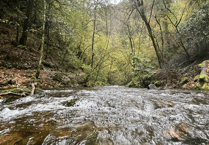A DARTMOOR mine dates back more than 1,000 years, research has revealed.
Kelly Mine produced a rare variety of iron oxide, used for many industrial purposes, and was active from the 18th century through to 1951.
While volunteers were renovating one of the old mine workings, a concentration of slag was unearthed; residue from bloomery smelting, an ancient process by which wrought iron was produced from iron ore.
Dartmoor National Park’s archaeologist, Dr Lee Bray, has been examining and recording the fragments.
He said: ‘The finds are very exciting because it puts the history of human activity at Kelly Mine back probably by over 1,000 years, certainly much earlier than 18th Century.
‘The types and quantities of slag present suggests iron was being produced on a relatively small scale, probably just for local needs. The material looks unlike the typical waste from medieval or Roman iron production, and it is possible we are looking at evidence for prehistoric smelting on the site.
‘It’s a valuable insight into a lesser-known part of Dartmoor’s history. While its tin mining and industrial sites attract lots of attention, it’s fascinating to discover fresh information that shows a wider range of minerals have been exploited in the region..
Kelly Mine is one of Dartmoor’s best kept secrets and has great significance as an industrial heritage site. The first reference to workings date to around 1797 but the first official record of the mine is in 1877. It finally closed in 1951.
The equipment and site remained untouched for years until 1984 when the landowner leased the site to a group of mining enthusiasts.
Kelly Mine Preservation Society (KMPS) has been restoring this site for future generations; conserving it as a working memorial to a now-lost Dartmoor industry. They have refurbished the mine and restored the processing machinery to working order, among much more.
It is now a perfect time capsule and has a unique collection of mining equipment including ore washing, stamping equipment, waterwheels and the mine tramway with its wagons and haulage winch.
There is also a small museum and display of artifacts from other mines in the area.
KMPS secretary Nick Walter said: ‘The whole project would not have been possible without the support and blessing of the landowners at Kelly Farm, and countless hours of dedicated effort from society members. We are delighted the site can now be made available to visitors again and are also actively seeking volunteers to join us.’
Following the easing of lockdown restrictions, people can now visit Kelly Mine and see its remarkable history for themselves. It’s free to visit but donations are welcome and go towards the site’s upkeep.
Visit the Kelly Mine website for more details about volunteering, site accessibility and further booking details.





Comments
This article has no comments yet. Be the first to leave a comment.